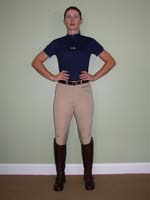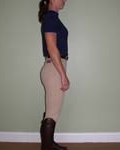Just because your back hurts when you finish riding, it doesn’t necessarily mean that riding is the problem. First investigate other predisposing factors that maybe the root of your pain. Poor posture, lack of fitness or an active injury are pertinent issues to review.
Riding with an active disc injury, sciatica, whiplash or sprains to your hip, knee or ankle may worsen your condition. Unless your healthcare professional confirms that riding with limitations would be safe while the injury is healing, you may be prolonging and complicating the injury. Unfortunately, too many riders take better care and spend more time on their horses then they do for themselves.
My philosophy toward good health is to practice what I preach, keep life’s priorities basic. As advanced as our society and our intelligence may seem, our bodies still function in a primitive way with a strong fight or flight reflex; yet we do have the ability to manipulate our environment to a kinder, better-balanced lifestyle. A foundation to develop optimal health is good posture and proper nutrition, sleep and fitness.
If you are a conscientious horse person and you care for and train your horse with any semblance of routine health and fitness, why should you treat yourself any differently? You are the other half of the partnership and you may be the limiting agent.
MINIMUM DEGREE OF FITNESS
As I tell my patients, it does not matter if you are an office worker or a construction worker, at the end of an average work day one should have enough energy to participate in life, family, and physical activities such as riding, bowling, biking or hiking. If you do not possess this minimal level of fitness, you are compromising your health and thus your competitive edge. Unfortunately, too many office workers report that they are exhausted and too tired to exercise after work. Emotional exhaustion can be remedied with motivation and motion.
Ten to 30 minutes of mild to moderate cardio activity a few times per week will complement your overall fitness and well being. Walk, bike or do an aerobics video or class.
My favorite strengthening exercises to teach riders are core strengthening exercises.
Your core strength comes from your abdominal and back muscles that balance your ribcage/torso over your pelvis. Having this balance and stabilization aids in proper spinal alignment and posture. The muscles that contribute to our core strength are the erector spine, internal and external oblique, rectus abdominus, and transverse abdominus muscles. It is the deepest muscle, the transverse abdominus that is key to core strength and the most overlooked. The transverse abdominus acts like a built-in corset. Surprising to most is the fact that having strong “abs” but a weak transverse abdominus muscle can actually cause lower back pain due to spinal misalignment.
If you take 3-4 minutes each day to do isometric core strengthening exercises you will be amazed how quickly it will benefit your fitness and posture! You can actually incorporate the isometric core strengthening concept into your daily routine of lifting, walking, grooming and living.
To activate your core is as simple as coughing. To perform a prolonged isometric contraction, sandwich your spine in neutral posture (do not tilt your pelvis, do not flatten or arch you lower back) visualize and pull your bellybutton back to your spine. Do not hold your breath, breath deeply from your diaphragm. Throughout the day perform these isometrics and your core will start to strengthen, your posture will improve and you will experience less stress on your spine and muscles.
LACK OF SLEEP
Too many people, children included, do not get enough quality sleep. This negative cycle may cause a variety of physical problems including immune-related health disorders, overeating and poor healing. Unfortunately, the coffee and caffeine craze just helps to perpetuate our lack of sleep.
Get to know your body. Ask yourself how much sleep is optimal for you. The average night’s sleep is 8 hours. Needing 2 hours more or getting 6 or less hours of sound sleep can be a sign of a sleep disorder. Be careful not to drink caffeinated beverages in the afternoon, as it can be disturb your sleep pattern. If you are tired during the day, drink some water. Dehydration can mimic fatigue and hunger.
POSTURE
Good posture can make you or break you. Most healthcare practitioners will agree that good posture is the cornerstone to good health. We as bipeds (walk erect on two feet) are constantly under the forces of gravity. Like a good architecture, the structure can withstand the test of time. Our spine is comprised of 24 movable vertebrae and sacrum designed with three primary curves which aid in efficient movement and protect our brain and spinal cord from the concussive forces.
The better and more efficient your posture is when you are off the horse (at work, at school, at home), the better your strength, flexibility and coordination will be when you are on the horse. Poor posture will compress your diaphragm, limiting the ease and volume of your resting and active respiration. Shallow breathing will cause fatigue when you are sedentary and restrict the expansion of the ribcage, mechanically reducing the maximum volume of air you can breath when you need it. Poor posture will also compress your internal organs and restrict the peristalsis (movement) of your digestive organs, thereby slowing digestion as well as elimination, adding toxicity to your entire system.

through their full range of motion. If your joints are limited in the range of motion, there is a smaller joint surface bearing the weight, causing more wear and tear and reducing the health of the synovial membrane and fluid. Good posture aids in maintaining balance between our muscular and skeletal structure, supporting efficiency of movement and thereby reducing wear and tear.
Postural reflexes from our nervous system may override any conscious effort to correct our riding position. Sitting in a properly fitted saddle (for both horse and rider) aids in good posture; yet when the horse moves off, our core weakness is revealed. You lean forward into the foreword movement of the horse in order to not fall off backwards, our hands will pull back to help rebalance the system and our knees will often draw up. This is a postural reflex for self- preservation (as your hand draws away from a burning flame before you are aware of it). We have all seen this in beginners, yet the primary postural reflex is always present.

Riding requires a retraining of our proprioceptive (awareness in space) reflexes just as gymnasts must refine their nervous system. Poor posture and tight muscles limit our conscious ability to retrain our postural reflexes.
FLEXIBILITY
Most common postural muscle imbalances are:
- anterior head carriage
- rounded shoulders
- rounded back
- unleveled shoulders or pelvis
Most common inflexibilities:
- tight chest muscles (pull the head and shoulders foreword
- tight hip flexors and quadriceps (over arch the lower back and compress the spinal joints)
- tight hamstrings (major cause of pain and injury to lower back and poor seated posture)
- tight calf muscles (foreword gravity line and loss of shock absorption through the lower limb and spine)
Most common postural weakness (especially in women):
- entire abdominal muscle group (weak core)
- neck and upper back muscles
Your posture, your fitness and your health are your responsibility. Start today and set a good example for your family, friends and students. It is possible to integrate and enjoy a healthier lifestyle to benefit you and your horses even if you start by only taking 5-10 minutes each day and focus on strengthening your core and improving your flexibility. Cross training is an excellent way to stay fit enough to ride. Your lessons and overall performance will improve dramatically at the same time you are reducing the risk of injury to your back. The most efficient and safest way to do this is to seek out a healthcare practitioner to pinpoint any limitations and teach the specific exercises and stretches to streamline your routine.
Don’t miss the opportunity if your horse has some down time or weather is limiting your riding — this is often a great time to make the most of your personal health and fitness.
RECOMMENDED READING
For stretching guidelines
“Stretching,” revised ed. Bob Anderson, copyright 2000, Robert A. Anderson and Jean E. Anderson.
For core strengthening
www.mayoclinic.com
– See more at: http://holistichorse.com/equine-therapy/ch290-dont-blame-your-back-pain-on-your-riding#sthash.pp80fcIl.dpufiropractic/
Patricia Bona, DC, lives and practices in Blue Bell, Pennsylvania. She graduated from Logan College of Chiropractic in 1986, and was certified by the American Veterinary Chiropractic Association in 1992. An avid equestrian most her life, currently riding and training her two horses, she is active in dressage, jumping and more recently Side Saddle competition.
– See more at: holistichorse.com/equine-therapy/chiropractic
Reprinted with permission from Holistic Horse.
